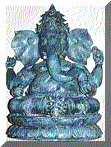

| Touchdown | Humayan's Tomb |
| India Gate | Birla Mandir |
| Lodi Gardens |
Touchdown
Arriving in India for the first time was not quite as much of a torment as I had been lead to believe by some of my more imaginative friends. Clearing customs, whilst slow ( there were six queues and we chose the slowest one ), kept moving. After picking up the rucksacks from the floor beside the long since deactivated conveyer belt, we proceeded to the outside world. It was only when we were faced with a wall of people did we begin to feel a bit edgy. We dove into the sea of bodies and tried to find a sign displaying 'Imaginative Traveller'. It was a relief that it was not too long before we met out contact (Raju) amongst the crowds and headed out of the airport. When we exited, it was night and the first thing that struck me was how dark Delhi was. We had arrived from Abu Dhabi, a well lit city at all times so I was not prepared for the relative lack of street lighting in Delhi. And boy, was it foggy! 'Not fog,' said Raju, 'smoke'. Yes, the smoke from thousands of inefficient fires, pouring out more fumes than therms, obscuring what little lighting there was. On the way into the city I spotted an optomistic sign: "Welcome to Clean Green Delhi".
Humayan's Tomb
We arrived the night before the tour was due to officially begin, so we took ourselves off, Rough Guide in hand to take a walk around Connaught Place. A quick scan of the book revealed an historic site known as Humayan's tomb in the local area. History is always a top drawer choice on our travels so we headed off in the general direction of the tomb. After an hour of ever decreasesing circles we found the tomb, not a mile's walk from our hotel (the Jukaso Inn). Hot and thirsty, we got some drink from the hawkers at the entrance and made our way in.
We were glad we'd persisted in our searching because the place was a welcome retreat of peace, clean air and open space which is at a premium elsewhere in the city. The tomb complex itself was beautiful, the gardens green and perfumed and the main building itself of red sandstone and marble. It was listed as a world heritage site alongside the Taj Mahal and it was easy to see why. The architecture was complex yet sombre in the Mughal style. The mausoleum housed the tomb of Humayan, the second Mughal Emporer and his father, Babar. It was a spectcular monument to a famous era in India's history. After 2 hours of wandering among the palmed gardens and inside and around the complex, admiring the views and enjoying the ambience we felt relaxed and revived from the previous days travels. The tomb of Humayan is a memorable, peaceful and nostaligic place, well worth visiting.
India Gate
India Gate is a first world war memorial that looks a lot like the Arc de Triomphe. It is situated at one end of the Rajpath, a long straight road, at the end of which stands the parliament buildings. In many ways, India Gate is the centre of New Delhi and is the focus of the Republic Day celebrations each year. It's central position, open parks and space make it a major attraction for locals and tourists alike. It is enjoyable to wander around, admire the Arch, fence with hawkers and take in some amateur (but deadly serious) cricket.
Birla Mandir
The Birla Temple is a large new complex dedicated to Lakshmi (goddess of wealth & beauty) , Krishna (god of love) and Ganesh (god of auspicious beginnings). It is hard at first remember any of the names of the gods and goddesses, much less their attributes and relationships. Then you get inside the temple and discover that the dedicated deities are the tip of the iceberg because, like many Hindu temples, there are small areas dedicated to numerous other divinities. Don't feel guilty though because this problem is shared with Hindu's themselves. There are more gods and goddesses in the religious pantheon for anyone to count, much less remember. Paradoxically, if you ask a Hindu which god's they worship, you will be surprised to hear the answer is one. All the millions of gods are just different manifestations of the three gods that form the holy trinity, Brahma (the creator), Vishnu (the preserver, husband of Lakshmi) and Shiva (the destroyer, father of Ganesh). These three are themselves simply three aspects of one single god signified by the Om symbol, so the bizarre response makes a lot of sense afterall.
Lodi Gardens
In south Delhi are the Lodi Gardens. Within the expansive and beautifully crafted gardens are a set of tombs and a mosque, now decayed and abandoned by all save the pigeons and chipmonks. Some of the tombs, like the glazed dome ('Shish Gumbad', shown) still preserve some of their original grandeur. This dome in particular would have been covered in blue glazed tiles, similar to those that still cling to the limestone blocks above the entrance. Most of the buildings' interiors still have the oringinal Koranic script intact, painted onto large stucco surfaces high above grasping hands. Taken altogther, Lodi Gardens are another pleasant area of Delhi to relax and it is not surprising that this is one of the most popular picnic sites in the city.

|
|
|
|
|
|
|
|